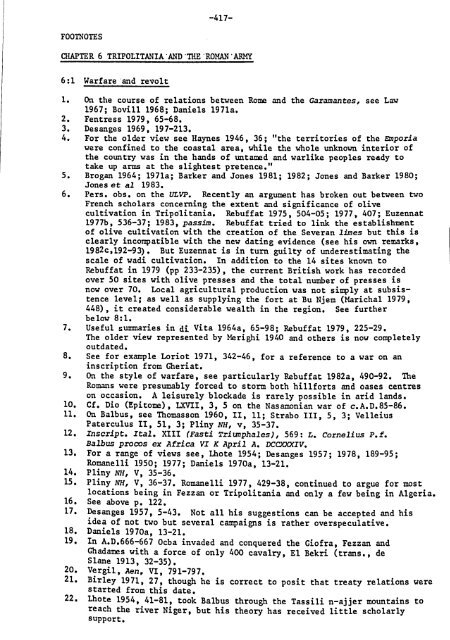a comparative study of a Roman frontier province. - Historia Antigua
a comparative study of a Roman frontier province. - Historia Antigua
a comparative study of a Roman frontier province. - Historia Antigua
Create successful ePaper yourself
Turn your PDF publications into a flip-book with our unique Google optimized e-Paper software.
-417-<br />
FOOTNOTES<br />
CHAPTER 6 TRIPODITANIA 'AND 'THE ' ROMAN ' ARMY<br />
6: 1 Warfare *and revolt<br />
1. On the course <strong>of</strong> relations between Rome and the Garamantes, see Law<br />
1967; Bovill 1968; Daniels 1971a.<br />
2. Fentress 1979,65-68.<br />
3. Desanges 1969,197-213.<br />
4. For the older view see Haynes 1946,36; "the territories <strong>of</strong> the Emporia<br />
were confined to the coastal area, while the whole unknown interior <strong>of</strong><br />
the country was in the hands <strong>of</strong> untamed and warlike peoples ready to<br />
take up arms at the slightest pretence. "<br />
5. Brogan 1964; 1971a; Barker and Jones 1981; 1982; Jones and Barker 1980;<br />
Jones et al 1983.<br />
6. Pers. obs. on the ULVP. Recently an argument has broken out between two<br />
French scholars concerning the extent and significance <strong>of</strong> olive<br />
cultivation in Tripolitania. Rebuffat 1975,504-05; 1977,407; Euzennat<br />
1977b, 536-37; 1983, passim. Rebuffat tried to link the establishment<br />
<strong>of</strong> olive cultivation with the creation <strong>of</strong> the Severan limes but this is<br />
clearly incompatible with the new dating evidence (see his own remarks,<br />
1982c, 192-93). But Euzennat is in turn guilty <strong>of</strong> underestimating the<br />
scale <strong>of</strong> wadi cultivation. In addition to the 14 sites known to<br />
Rebuffat in 1979 (pp 233-235), the current British work has recorded<br />
over 50 sites with olive presses and the total number <strong>of</strong> presses is<br />
now over 70. Local agricultural production was not simply at subsistence<br />
level; as well as supplying the fort at Bu Njem (Marichal 1979,<br />
448), it created considerable wealth in the region. See further<br />
below 8: 1.<br />
7. Useful summaries in di Vita 1964a, 65-98; Rebuffat 1979,225-29.<br />
The older view represented by Merighi 1940 and others is now completely<br />
outdated.<br />
8. See for example Loriot 1971,342-46, for a reference to a war on an<br />
inscription<br />
from Gheriat.<br />
9. On the style <strong>of</strong> warfare, see particularly Rebuffat 1982a, 490-92. The<br />
<strong>Roman</strong>s were presumably forced to storm both hillforts and oases centres<br />
on occasion. A leisurely blockade is rarely possible in arid lands.<br />
10. Cf. Dio (Epitome), LXVII, 3,5 on the Nasamonian war <strong>of</strong> c. A. D. 85-86.<br />
11. On Balbus, see Thomasson 1960, II, 11; Strabo III, 5,3; Velleius<br />
Paterculus II, 51,3; Pliny NH, v, 35-37.<br />
12. Inscript. Ital. XIII (Fasti Triumphales), 569: L. Cornelius P. f.<br />
Balbus procos ex Africa VI K April A. DCC XXIV.<br />
13. For a range <strong>of</strong> views see, Lhote 1954; Desanges 1957; 1978,189-95;<br />
<strong>Roman</strong>elli 1950; 1977; Daniels 1970a, 13-21.<br />
14. Pliny NH, V, 35-36.<br />
15. Pliny NH, V, 36-37. <strong>Roman</strong>elli 1977,429-38, continued to argue for most<br />
locations being in Fezzan or Tripolitania and only a few being in Algeria.<br />
16. See above p. 122.<br />
17. Desanges 1957,5-43. Not all his suggestions can be accepted and his<br />
idea <strong>of</strong> not two but several campaigns is rather overspeculative.<br />
18. Daniels 1970a, 13-21.<br />
19. In A. D. 666-667 Ocba invaded and conquered the Gi<strong>of</strong>ra, Fezzan and<br />
Chadames with a force <strong>of</strong> only 400 cavalry, El Bekri (trans., de<br />
Slane 1913,32-35).<br />
20. Vergil, Aen, VI, 791-797.<br />
21. Birley 1971,27, though he is correct to posit that treaty relations were<br />
started from this date.<br />
22. Lhote 1954,41-81, took Balbus through the Tassili n-ajjer mountains to<br />
reach the river Niger, but his theory has received little scholarly<br />
support.

















